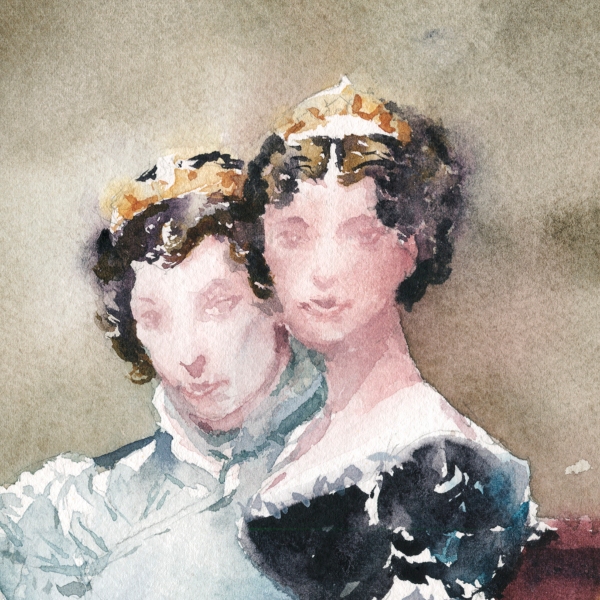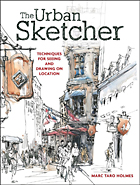Cloning Napoleon’s Nieces
I was at the museum traipsing through a show on Napoleon. Ran across this double portrait by Jacques-Louis David portraying Napoleon’s nieces Zénaïde and Charlotte.
In the painting, (according to the didactic panel), they are posing as steadfast echoes of the Empire.
Crowned with gold tiaras, perched on a chaise decorated with imperial bees (?) < apparenlty a Bonaparte logo), brandishing a letter from uncle Joseph, no doubt encouraging them to produce lots of sons who might yet become future emperors. (Zéni. had 12 kids, Lottie – dunno – couldn’t find that info – but they both died in childbirth).
In any case – I felt like making a study, and so, here it is. And, as always, it’s about as faithful as anything I paint :) I want to learn – but I learn by play :)
I’m no expert, but it’s my understanding the jury is out on the practice of master copies.
Other than the secluded chambers of artist’s ateliers or the Chinese art factories – is anyone else doing them?
Send me some links if you are! Please post in the comments. I’d like to hear what other people are doing.
>
When I went to school, we were discouraged from copying historical painting. Other than as appropriation in the context of critical analysis. Which is a fancy way of saying – other than making fun of them.
I understand of course that we were being positioned against of all the misogyny and class warfare and imperialism inherent in the work. (I can get behind that). And as good students, we would turn our backs on the patriarchy of representation and make conceptual art. (That — I couldn’t quite get there).
But isn’t it more interesting what we can learn from this painting?
I find it fascinating how this is a kind of propaganda. The use of art, beauty, and elegance to portray a kind of right thinking young lady doing their part for the empire.
What virile King of Spain wouldn’t want one of these ladies as wives?
Deposed King Ferdinand as it turns out, refused Zéni’s hand. Forcing her to marry her cousin Charles – sire of those 12 pure-blood kids.
>
The best thing you can say (about the death of master-copies) is that art colleges are not trying to produce skilled-but-slavish craftspeople any longer. Rather, we want free-thinkers.
I think this is fallout from the post-war obsession with originality in art, which is can be blamed on the explosion of (artificial) value in contemporary art, and the perceived need for every single piece to be 100% from our own mind – so we’re always adding value to our portfolio.
This is something collectors want – as they need a body of work they can collect, market, and profit from.
It’s not necessarily anything artists should want – as they need to be thinking first about developing their skills.
You know – if you ask me :)
~m




I certainly sketch works of art in galleries. I often prefer sculpture, but do also work on paintings. Personally I find the discipline of taking the time to really look at a work is the prime benefit, it’s another way of training your visual acuity. My sketches aren’t academic studies, but I get a real pleasure from making them. Last but not least such sketches stay with you longer than any photo does.
Begun last week at Louvre. Finished at home. 4 hours. Pencil on Canson mi-teinte.
________________________________
Bonnie! I think the link is missing? Can you resend :)
I have been thinking about doing more of this for a while (since last time I did master artwork copies back at school Art lessons), and so I finally decided to pick my favourite artists one by one and do some studies of their works.
Here was the first one:
Thank you for bringing up the topic of art skill vs value, it’s something I keep thinking lots about, a bit of a sore point.
Oh great choice! Lovely painting to work with :) Works so well with the metallic pigment too.
I wonder if you did thumbnails or a value sketch before painting? For me copying is a wonderful way to walk in someone else’s shoes. What better way to learn what the old masters have to teach us? It seems here David is doing a riff on Ingre’s portraits, the way the faces stand out from the rest of the picture. The odd pose of doubling up is Davids though. Interesting how the red/green complimentary color composition dominates in what is surely a value painting. And the way he uses the drapery to keep your eye moving around inside what is a pretty static picture. Perhaps this portrait was sent out to find husbands for them? What sad fate they met up with..
I really do love the hand gesture on the waist, and the way they’re pressed so closely together. The girl in blue has maybe a shy look? All that makes it seem like David felt for their story too!
Nope I didn’t make a value study – I should have – as mine isn’t that close :) But that’s watercolor vs. oils for you!
When I dont do a pencil value study first my watercolors completely suck!
Around 1860 when Edgar Degas was in his mid-twenties he “copied” Delacroix’s Entry of the Crusaders into Constantinople (1840). Clearly Delacroix’s original (right) is about war and religion but Degas knew that, underneath, art and the artist’s mind were the subjects of any painting by a master.
http://www.everypainterpaintshimself.com/article/degas_delacroix_on_entry_of_the_crusaders_into_constantinople_c.1860
I think you’re too kind to the schools who turned their backs on hundreds of years of art simply because representational art was seen as passé. We learn by analyzing and copying works of our betters. I copy your work all the time (grin).
When you asked about pointers to people who do/discuss this, Cesar Santos came to mind immediately. Here’s a couple links but his YouTube channel is full of art museum analysis and philosophical stuff about art.
Direct discussion of master copies and their value:
A trip through one of his “sketchbooks” (he does complete oil painting in his sketchbook)
Here’s a tour of his latest show – a modern take on classical art
THANK YOU Larry!
These are terrific and to the point.
You made some interesting choices in your study, but the most striking one to me is to NOT focus on the faces as the original piece does. Was that a deliberate choice? Or was it to not get too fussy? Did they not interest you? I’m intrigued…
Aha! Yes! – what I love about David (and all these academic painters) is the way the values are so well organized. And the way they shamelessly block color. It’s deceptively simple! The dress is Blue. Blanket is Red. Every color block is clean and well defined. My watercolor copy is higher key than the oil version – because transparent pigment – but otherwise, I was just looking at those shapes and engoying the design of the painting. (I modernized the figures, (slimmer) and raised her hand by accident, but I like it with the letter higher actually).
And besides that, I thought these poor girls story was kind of spooky, so I wanted them to look a bit ghostly. So the faces are kind of pale impressions :)
I took a 10-week class in pen-and-ink drawing a couple years ago, and we spent the entire time copying the masters. I had never done much of that before. I really enjoyed it and learned so much. That was at the Gage Academy in Seattle, which is known for teaching in very traditional ways. Someday maybe I’ll learn to “express,” but for now, I’m happy to just learn to draw. ;-)
– Tina
LOL I couldnt resist the challenge 😄 Thanks Marc
Carol Gillott Paris in your mailbox Blog:www.ParisBreakfasts.blogspot.fr Shop:www.etsy.com/shop/ParisBreakfast Instagram:https://instagram.com/parisbreakfast
>
Interesting as copying a painting was an elective at the art school I went to in Philadelphia–Pennsylvania Academy of the Fine Arts. Very classical school. I never did that but a friend did and I watched her progress as she copied a painting by Homer winslow.( It was one the museum of the school owned. ) To do this, the school had papers attached to the back claiming it was a copy, etc. etc.
But the point is that she learned a lot by doing this along with an instructor. The artists approach, color layering, etc. So it is a good exercise. Credit to you for doing this.
I am working through the book Tate Watercolour Manual, Lessons from the Great Masters and basically it’s copying Claude Lorraine, Jean-Baptiste-Camille Corot and (gulp!) J.M.W. Turner. I’m learning lots!
That sounds like a great book. A great concept that might not go into print today? or is it recent and proving me wrong ;)
Definitely a recent publication, 2014. Joyce does the scientific analysis and Tony does the painting side of things. I did a fantastic workshop with Tony in association with the Turner exhibition at the National Gallery of Australia, a few years back. Joyce was also there to discuss Turners pigments and paper. Wonderful experience.
I just took a 1 day Jane Barnard class on John Singer Sargent techniques. The goal was not so much to make copies, but to study color choice and brush strokes.
I love your copy :) – especially your talent in simplifying a scene. I tried my hand at ‘sketching’ my impression of Elisabeth Vigee Le Brun’s self portrait couple of years ago posted in my@artbymeera Instagram. : https://www.instagram.com/p/BC05dd8tyjUsFSwN3TnpjLd0G5jHlxJMlLEUYs0/?taken-by=artbymeera .
I don’t know EV LeBrun – see, that’s another aspect – what art we choose to copy, brings history up to date!
:) do look her up – she is an amazing artist and person- MET had a wonderful show on her in 2016 .
Curious… in school, we were encouraged to sketch and paint in the museums and “learn from the masters”. Not to sell or anything but to understand how they accomplished shading, color, form, line quality, etc. We learn so much from doing… even if someone’s work is not to our taste or style, the act of trying to mimic their technique can then inform our own work. I grew up dancing classical ballet so we were always taught technique, technique, technique… then you can “do your own thing”.
In the 1970’s I copied a number of Klimt and Vuillard paintings. Throughout the following decades I have referred back to the multitude of lessons I learned by copying those paintings. I learned techniques that expanded my toolbox three-fold. I learned how to look more deeply and carefully at the technique of paintings. I learned the power of a few flicks of red in just about any and all paintings. By copying Klimt and Vuillard I was cut loose from preconceived notions of painting in oil. I was set free. I have carried that freedom into all media.
Everyone knows Klimt but I hadn’t heard of Vuillard. Will go look – this is the best side benefit. Regular art history was boring. Art master copy Class would have been way better. :)